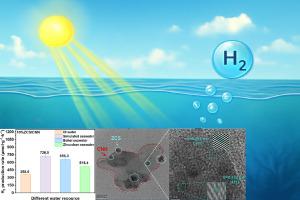模拟或自然海水光催化析氢双金属硫化物/氮化碳纳米复合材料的构建
IF 4.7
3区 化学
Q2 CHEMISTRY, PHYSICAL
Journal of Photochemistry and Photobiology A-chemistry
Pub Date : 2025-09-25
DOI:10.1016/j.jphotochem.2025.116810
引用次数: 0
摘要
采用浸渍法制备了ZnCo2S4/g-C3N4 (ZCS/CNN)纳米复合材料,并将其用于不同水源的光催化析氢。并对其结构、形态和光电化学性质进行了全面的研究。优化后的10% ZCS/CNN纳米复合材料在去离子水、模拟海水、渤海海水和舟山海水中的产氢率分别为358.9 μmol·g−1·h−1、726.5 μmol·g−1·h−1和516.4 μmol·g−1·h−1,优于CNN和ZCS。除了具有优异的光催化性能外,该催化剂在四个循环中表现出很高的稳定性。活性的增强主要归因于s型异质结的形成,它降低了反应阻抗,增加了光电流,促进了有效的电子空穴分离。本研究开发的g- c3n4基光催化材料在海洋制氢方面具有实际应用前景。本文章由计算机程序翻译,如有差异,请以英文原文为准。

Construction of bimetallic sulfide/carbon nitride nanocomposites for photocatalytic hydrogen evolution from simulated or natural seawater
ZnCo2S4/g-C3N4 (ZCS/CNN) nanocomposites were synthesized using the impregnation method and employed for photocatalytic hydrogen evolution from various water sources. The structural, morphological, and photoelectrochemical properties were also thoroughly examined. The optimized 10 % ZCS/CNN nanocomposite demonstrated hydrogen production rates of 358.9 μmol·g−1·h−1 in deionized water, 726.5 μmol·g−1·h−1 in simulated seawater, 656.3 μmol·g−1·h−1 in Bohai seawater, and 516.4 μmol·g−1·h−1 in Zhoushan seawater, outperforming both CNN and ZCS. Besides its exceptional photocatalytic performance, the catalyst exhibited high stability over four cycles. The enhanced activity is primarily attributed to the formation of an S-scheme heterojunction, which lowers reactive impedance, increases photocurrent, and promotes efficient electron-hole separation. The g-C3N4-based photocatalytic materials developed in this study hold promise for practical applications in marine hydrogen production.
求助全文
通过发布文献求助,成功后即可免费获取论文全文。
去求助
来源期刊
CiteScore
7.90
自引率
7.00%
发文量
580
审稿时长
48 days
期刊介绍:
JPPA publishes the results of fundamental studies on all aspects of chemical phenomena induced by interactions between light and molecules/matter of all kinds.
All systems capable of being described at the molecular or integrated multimolecular level are appropriate for the journal. This includes all molecular chemical species as well as biomolecular, supramolecular, polymer and other macromolecular systems, as well as solid state photochemistry. In addition, the journal publishes studies of semiconductor and other photoactive organic and inorganic materials, photocatalysis (organic, inorganic, supramolecular and superconductor).
The scope includes condensed and gas phase photochemistry, as well as synchrotron radiation chemistry. A broad range of processes and techniques in photochemistry are covered such as light induced energy, electron and proton transfer; nonlinear photochemical behavior; mechanistic investigation of photochemical reactions and identification of the products of photochemical reactions; quantum yield determinations and measurements of rate constants for primary and secondary photochemical processes; steady-state and time-resolved emission, ultrafast spectroscopic methods, single molecule spectroscopy, time resolved X-ray diffraction, luminescence microscopy, and scattering spectroscopy applied to photochemistry. Papers in emerging and applied areas such as luminescent sensors, electroluminescence, solar energy conversion, atmospheric photochemistry, environmental remediation, and related photocatalytic chemistry are also welcome.

 求助内容:
求助内容: 应助结果提醒方式:
应助结果提醒方式:


